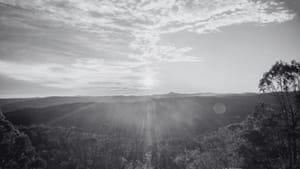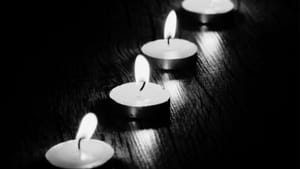The Pathway of Clear Seeing
You pause beside moving water. Leaves drift past—some torn, some whole—none require rescue. You simply watch them travel, feeling neither urge to grab nor impulse to judge. In that quiet gaze, the Pathway of Witness awakens.
This is not passive observation. It is not detachment. Witnessing, in its sacred form, is presence deepened into clarity. You are here. You see. And you do not turn away.
To witness is to hold a mirror without distortion or demand. It is to say: I see this. I see you. I see myself. Not with critique. Not with control. But with reverent truth.
The Pathway of Witness begins where reaction ends. It asks: Can you stay present to what is—even when it’s messy, raw, incomplete? Can you soften the need to explain, rescue, or resolve, and instead meet the moment as it truly is?
Witness is the sacred art of staying. Of noticing the full motion of becoming without interruption. Of honoring the unspeakable without forcing it into language. To witness is to hold space without inserting story. And in this way, witness becomes the ground of healing, the portal of recognition, the edge where truth no longer hides.
To witness is to see clearly without turning away. But it’s not the same as judging.
The judge acts from certainty. The witness moves with compassion.
The judge seeks control. The witness seeks understanding.
The judge declares finality. The witness allows unfolding.
As we move deeper into this pathway, the next step is subtle but essential: learning how to differentiate between witnessing and judging—how to stand in truth without crossing into assumption or condemnation.
Because what you witness is sacred.
And how you witness it… makes all the difference.
Witness or Judge?
The Posture That Shapes What You See
Not all seeing is the same.
You might think you’re witnessing—but inside, your breath is tight, your body coiled, your eyes narrowed. What you’re doing isn’t witnessing—it’s judging. And the difference is not just semantic. It’s energetic. It’s existential. Because the way you look changes what you see.
To witness is to open. To soften. To breathe into the unknown without rushing to label it. The Witness brings presence without defense. It’s the part of you willing to stand beside, not above.
To judge, on the other hand, is to constrict. It’s the collapse into certainty before truth has even had a chance to speak. Judgment is the mind gripping a story and forcing reality to fit. It narrows possibility down to a verdict. And in doing so, it fragments both seer and seen.
Here’s how to feel the difference:
|
Lens |
Posture |
Result |
|
Witness |
Open stance, soft eyes, breath slow |
Clarity, compassion, accurate insight |
|
Judge |
Tension, narrowed focus, breath withheld |
Contraction, blame, distorted perception |
When you judge, you edit reality. You trim it down to what feels safe or familiar. But when you witness, you let reality reveal itself. You let it speak its shape in full, uncut truth.
This is not a passive act. Witnessing takes strength. It requires your willingness to feel without fixing, to see without shrinking, and to remain present even when what you see asks something of you.
To witness is to meet the moment with reverence.
To judge is to try to control it.
And here, the Pathway deepens.
Because the next layer of witness asks not only how you see—but what you’re willing to stand beside when truth arrives unfiltered.
The Mirror Turns Inward First
You’re sitting at your desk. Another email pings in. A heaviness tightens your chest, your jaw locks, and your stomach drops. No one else is in the room. But something in you just flinched. And you almost didn’t notice.
This is a moment of self-witnessing.
Not to fix. Not to suppress. But to pause and turn gently toward the sensation.
To say: I see you. I feel this. I’m here.
To recognize the weather of the moment without confusing it for the entire sky.
Witnessing isn’t just how you see others. It’s how you choose to see yourself—without distortion, without demand.
And when that lens is clear within, it opens outward to hold others and the world with the same clarity of presence.
Here are the three modes of witnessing:
1. Self-Witness
Observe your internal world with compassion.
Let thoughts, emotions, and body sensations pass like clouds across a sky—temporary, shifting, revealing. You are not the storm. You are the one watching the weather. Self-witnessing dissolves self-judgment and builds the ground for true self-trust.
2. Other-Witness
Witnessing others is more than hearing words. It’s listening for what trembles underneath: the clench in a shoulder, the pause before a “yes,” the meaning that lives in silence. To witness another is not to solve, analyze, or mirror back your own story—it is to hold space without collapsing into it.
3. Collective-Witness
Zoom out. What patterns rise and fall across your community, your lineage, your world?
Witnessing here means noticing the tide without needing to dam the river. It’s the capacity to see injustice, beauty, and change without becoming numb or reactive. This is where witness becomes a bridge—between personal awareness and collective awakening.
Each mode of witnessing sharpens your capacity for empathy. And each mode softens your instinct to project.
To witness is to say: I will not make this moment into a story I already know.
Instead, I will let this moment tell me what it is.
And from here, we move to the inner tension: What happens when what you see—especially within—hurts?
Let’s explore the courage to witness what’s uncomfortable.
The Courage to Witness What Hurts
Some truths arrive with sharp edges. The words you wish you hadn’t said. The grief you thought you’d buried. The pattern you swore you’d broken but didn’t.
To witness isn’t always soft. Sometimes it scorches. Sometimes it cracks illusions you've clung to for decades. Sometimes it demands you stay with the ache instead of racing to resolve it.
But this is where witness becomes medicine. Not because it heals instantly—but because it refuses to abandon what is real.
To witness what hurts requires three things:
1. Permission — to feel without needing to justify.
2. Patience — to sit with discomfort long enough to learn from it.
3. Presence — to resist the urge to numb, flee, or make meaning too soon.
You might feel the instinct to judge, to flee into fixing, or to spiritualize the pain away. But sacred witnessing is not a bypass.
Witnessing is a steady gaze that says: I will not turn away from what is true. Even if that truth makes me tremble.
This is the edge of the mirror—where presence meets pain, and reflection begins to reshape reality.
Because once you’ve seen clearly, once you’ve held space for truth without flinching…
You’re ready to integrate.
To step beyond witnessing into movement, into choice, into the alchemy of transformation.
Practices to Enter Witness
Three Ways to Practice Sacred Witness
Witnessing isn’t a mindset you flip on—it’s a muscle you build. And like any muscle, it strengthens through deliberate practice.
After all, witnessing isn’t just seeing. It’s learning to stay. To soften the impulse to fix or label. To meet the truth of what’s here, without trying to make it prettier or smaller.
These three practices open different doors into the stance of sacred witness. Choose one. Try all. Let them teach you how to see with more than just your eyes.
Mirror Gaze
What happens when you truly meet yourself?
Sit before a mirror. Let your gaze soften—not to inspect, but to receive.
Allow every flicker of expression, every wince or tear, to rise without correction.
Don’t perform presence. Don’t force love.
Just stay.
The longer you look, the more the masks fall—and what’s left is not flaw, but essence.
24-Hour Neutrality Challenge
What if nothing needed your immediate opinion?
For one day, every time you catch yourself labeling something—delicious/disgusting, ugly/beautiful, good/bad—replace it with: “That’s interesting.”
This isn’t repression. It’s retraining. At day’s end, journal what changed. You’ll likely find that the world grew wider—and so did you.
Compassionate Noticing Journal
Can you witness emotion without collapsing into it?
When a big feeling rises, don’t dive into the story. Instead, grab your journal and note where the sensation lives in your body. Tightness in the jaw. Heat behind the eyes. A pulsing in the chest. No fixing. No explanation. Just compassionate data. Over time, this builds emotional fluency—and a powerful sense of sovereignty.
Know this: practice makes presence resilient.
The more you witness with kindness, the more your perception shifts from control to compassion.
This is where the witness transforms into a weaver. Where insight becomes embodied. Where what you’ve seen begins to change how you live.
The Alchemy of Clear Witnessing
To witness is to stand with truth uncloaked. To look at life—your life, someone else’s life, the world’s life—without reaching to fix, judge, or flee.
And when you do? Something astonishing happens.
Clarity becomes transformation. The moment you fully meet reality—without amplification or mask—energy that once clung to distortion begins to release. Joy doesn’t need to be proven. Pain no longer needs to be denied. And what was once bound in loops of resistance starts to move—spiraling toward new motion, new possibility, new power.
This is the alchemy of sacred witness:
What is seen, with love and without agenda, begins to shift.
False narratives fall away. What’s real begins to breathe again. And from that breath, your next step emerges—authentic, unforced, aligned.
But of course, like any deep practice, witnessing wobbles.
When the Witness Wobbles
Witness is not perfection. It’s practice. And like walking a tightrope of awareness, it’s natural to sway. What matters is how you return.
Here’s how the wobble may show up—and how to meet it with breath and grace:
Over-Identification
You merge with what you observe. Their grief becomes your storm. Your past pain hijacks present truth.
Return to center with breath. One hand on the belly. Exhale slowly. You are the witness, not the wave.
Emotional Flood
Truth hits hard. Tears surge. Rage ignites.
Don’t retreat. Pause. Hand to heart. Name what’s here aloud: “This is sorrow.” “This is fury.” Naming is anchoring.
Avoidance Disguised as Detachment
You convince yourself you're witnessing—but really, you're numbing. You float above instead of entering with clarity.
Gently come back to the body. Wiggle your toes. Feel your weight. Remember: neutrality is presence, not absence.
These moments aren’t failure.
They are invitations to re-enter, more rooted and awake.
Witnessing is a Living Edge
There is no arrival, no final badge of enlightened observation.
There is only the breath-by-breath choice to stay open.
To see without shrinking.
To let truth be what it is—and allow that truth to move you.
And when that happens, when clarity meets courage, something new begins to take shape:
A life not just seen… but integrated.
The Gift Held in Witness
To witness is to stand at the threshold of truth—without flinching.
You don’t force clarity. You allow it to arrive, breath by breath, in a gaze softened by compassion.
This is not about detachment or cool observation.
This is about clarity without cruelty—seeing life as it is and, paradoxically, loving it more.
Because when you stop needing reality to match your expectations, you begin to meet it with reverence. And in that reverent gaze, a miracle unfolds:
Next steps emerge—not from panic, pressure, or performance—but from coherence. From the kind of inner knowing that doesn’t rush, doesn’t grasp, doesn’t manipulate.
Witnessing softens the inner walls you didn’t realize you’d built. It unhooks the loops of reaction and makes space for something deeper to move through—not a performance of integration, but a lived expression of it.
Witness is the breath before motion.
Integration is the motion itself.
And now, we turn toward that motion.
What does it mean to live from the inside out?
To let your seen truth move your life?
Next in the series: Living Inside-Out: What Is the Pathway of Integration?




